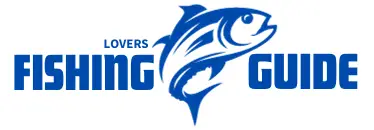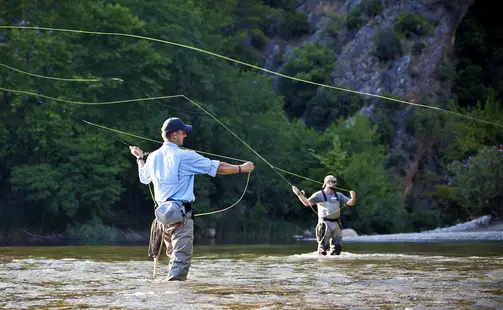Learn how does fly fishing work with the help of my lesson. This step by step guide is very simple and helpful.
How Does Fly Fishing Work
Fly fishing works by using a specialized fishing rod and artificial flies to catch fish, mimicking the insects they prey upon. With a combination of casting techniques and precise presentations, fly anglers entice fish to strike their flies through lifelike movements and natural drifts on the water’s surface or below it.
As a traditional angling method, fly fishing requires skill and practice to effectively imitate the behavior and appearance of the targeted prey, resulting in a successful catch. It is enjoyed as both a recreational activity and a competitive sport worldwide, appealing to those seeking a deeper connection with nature and a challenging fishing experience.
Whether fishing for trout in a mountain stream or pursuing tarpon in saltwater flats, fly fishing offers a unique and rewarding way to engage with the natural world. In this article we share details about how does fly fishing work .
The Basics Of Fly Fishing
What Is Fly Fishing ?
Fly fishing is a captivating and rewarding sport that uses a specialized technique to catch fish. Unlike traditional fishing methods, fly fishing relies on a fly, which is an artificial lure designed to mimic insects or other small creatures that fish feed on.
How Does Fly Fishing Work ?
Fly fishing is a technique that uses an artificial fly to catch fish. Anglers cast the fly using a light-weight rod and line, imitating natural insects or baitfish. The key is to present the fly in a way that entices fish to strike.
Fly fishing requires skill and knowledge of aquatic ecosystems.
The Gear You’ll Need
Before you venture out to try fly fishing, you’ll need to have the right gear. Having the proper equipment is crucial for a successful and enjoyable experience. Here’s a breakdown of the essential gear you’ll need:
| Item | Description |
| Fly Rod | A fly rod is a long, flexible fishing rod specifically designed for fly fishing. It allows for precise casting and control. |
| Fly Reel | A fly reel is a mechanical device that holds the fishing line. It also has a drag system that helps control the movement of the line when a fish is hooked. |
| Fly Line | A fly line is a specialized fishing line that is thicker and heavier than traditional fishing lines. It enables the angler to cast the fly accurately and carry the line through the air. |
| Leaders and Tippets | A leader is a clear, tapered section of line that connects the fly line to the fly. Tippets are the thin, transparent extensions of the leader that attach the fly to the rest of the leader. |
| Flies | Flies are the artificial lures used in fly fishing. They come in various sizes, shapes, and colors to imitate different insects and attract fish. |
| Waders and Boots | Waders are waterproof pants worn by fly anglers to keep dry while standing in the water. Boots with special soles provide traction and protection. |
| Other Accessories | Various other accessories, such as nippers, forceps, and a fly box, are essential for fly fishing. These tools help with knot tying, hook removal, and fly organization. |
Now that you know what fly fishing is and the gear you’ll need, you’re ready to dive into this captivating sport. So grab your gear, head to the water, and embark on a fly fishing adventure!
Understanding Fly Reels
Fly fishing is a captivating sport that requires precision and skill. At its core, fly fishing involves u.sing artificial flies to imitate the movement of insects on the water’s surface in order to lure fish. One of the essential components of fly fishing is the fly reel, which plays a crucial role in casting and retrieving the fly line. In this article, we’ll delve into the anatomy of a fly reel and explore the different types available, helping you gain a deeper understanding of how fly fishing works.
Different Types Of Fly Reels
Fly reels come in various types, each designed to cater to different fishing scenarios and preferences. Here are some of the most notable types:
Single Action Reels: These reels have a simple design where a single turn of the handle retrieves a fixed amount of line. They are lightweight and ideal for beginners or fishing in smaller streams and rivers.
Multiplier Reels: This type of reel features a gearing mechanism that allows for faster line retrieval with less effort. They are well-suited for tackling larger fish or fishing in saltwater environments.
Large Arbor Reels: With a wider spool diameter, these reels can hold more line and backing, providing increased line retrieval speed and reducing line memory. They are commonly used in situations where longer casts and quick line recovery are necessary.
Click and Pawl Reels: These traditional reels use a click and pawl mechanism to create drag. They are favored by fly anglers who enjoy the nostalgic feel of classic fly fishing and the simplicity of their design.
Understanding the different types of fly reels and their respective features allows you to choose the reel that best matches your fishing style and target species. Each reel type offers unique advantages, so it’s important to consider your fishing goals before making a decision.
Matching The Hatch
When it comes to fly fishing, one of the essential skills that anglers must develop is the ability to match the hatch. This skill involves identifying the insects that are hatching in the water and selecting an artificial fly that closely resembles them. While it may sound simple, matching the hatch is a crucial element of successful fly fishing.
Importance Of Identifying Insects
Insects play a vital role in the ecosystem of a river or stream, and trout and other fish species heavily rely on them as a food source. Identifying the specific insects that fish are feeding on during a hatch allows you to imitate their behavior and appearance, making your fly appear irresistible to hungry fish.
In addition to increasing your chances of getting a strike, identifying insects can also help you understand the preferences and behavior of fish. Each insect species has unique characteristics, such as the way they move on the water’s surface or underwater. By observing the insects closely, you can mimic their movements and behavior, fooling even the most wary fish.
Choosing The Right Fly
Choosing the right fly is the next step once you have identified the insects. Your fly should closely resemble the insects in size, shape, color, and behavior. There are different types of flies, such as dry flies, nymphs, and streamers, each designed to imitate specific stages of an insect’s life cycle.
For example, if you’ve observed mayflies hatching, you would select a dry fly fly that mimics the adult mayfly. It should have the same size, body shape, and color as the real insect. On the other hand, if you notice stoneflies crawling on rocks, you would choose a nymph fly that resembles the immature stage of the stonefly.
Remember that trout and other fish are highly attuned to even the smallest details, so your fly should be as accurate as possible. Effective matching of the hatch will greatly increase your chances of enticing fish to strike your fly and enhance your overall success as a fly angler.
Nymphing Techniques
Nymphing is a highly effective technique for catching fish, especially when they are feeding beneath the water’s surface. By imitating aquatic insects in their nymph stage, you can entice even the most selective fish to bite. Here are a few popular nymphing techniques:
Indicator Nymphing: This technique involves suspending a nymph beneath a small floating indicator. When the indicator moves or dips, it indicates a strike, allowing you to set the hook.
European Nymphing: Also known as tight line nymphing, this method eliminates the use of an indicator. By using a longer leader and keeping direct contact with your fly, you can detect subtle strikes and feel the fish’s movement.
Swing Nymphing: This technique involves casting upstream and allowing the nymph to drift downstream. As the fly swings across the current, it mimics the natural movement of an insect and entices fish to strike.
Dry Fly Fishing Strategies
Dry fly fishing is a thrilling and visual method that involves presenting a floating fly on the water’s surface. Here are some effective strategies to consider:
Matching the Hatch: Observing the water for hatching insects and selecting a fly that closely resembles the natural bugs can significantly increase your chances of success.
Drag-Free Drift: When presenting a dry fly, it’s crucial to achieve a drag-free drift. This means allowing the fly to float naturally down the current without any unnatural movement that may spook the fish.
Presentation Accuracy: Accuracy in casting is vital for dry fly fishing. Properly placing the fly in the feeding lane of the fish increases the likelihood of enticing a strike.
Frequently Asked Questions For How Does Fly Fishing Work
What Equipment Do You Need For Fly Fishing?
To get started with fly fishing, you’ll need a fly rod, reel, and fly line. Additionally, you’ll need flies that imitate various insects or baitfish. Other essential equipment includes a leader and tippet, which connect the fly line to the fly.
Optional tools include waders, boots, a vest, and polarized sunglasses.
How Do You Cast A Fly In Fly Fishing?
In fly fishing, casting involves using the weight of the fly line to cast the fly towards the desired target. The casting technique involves forming loops of line, allowing the fly to be accurately placed on the water. The fly line is controlled by false casting, backcasting, and forward casting motions.
Last Word
Fly fishing is a fascinating angling technique that involves casting a carefully designed fly onto the water’s surface to entice fish. By understanding the equipment, various casting methods, and different types of flies, anglers can master this art form. Although it may appear challenging, with practice and patience, anyone can enjoy the thrill of fly fishing.
So gear up, head to your favorite fishing spot, and explore this enjoyable and rewarding sport. Happy fly fishing!

